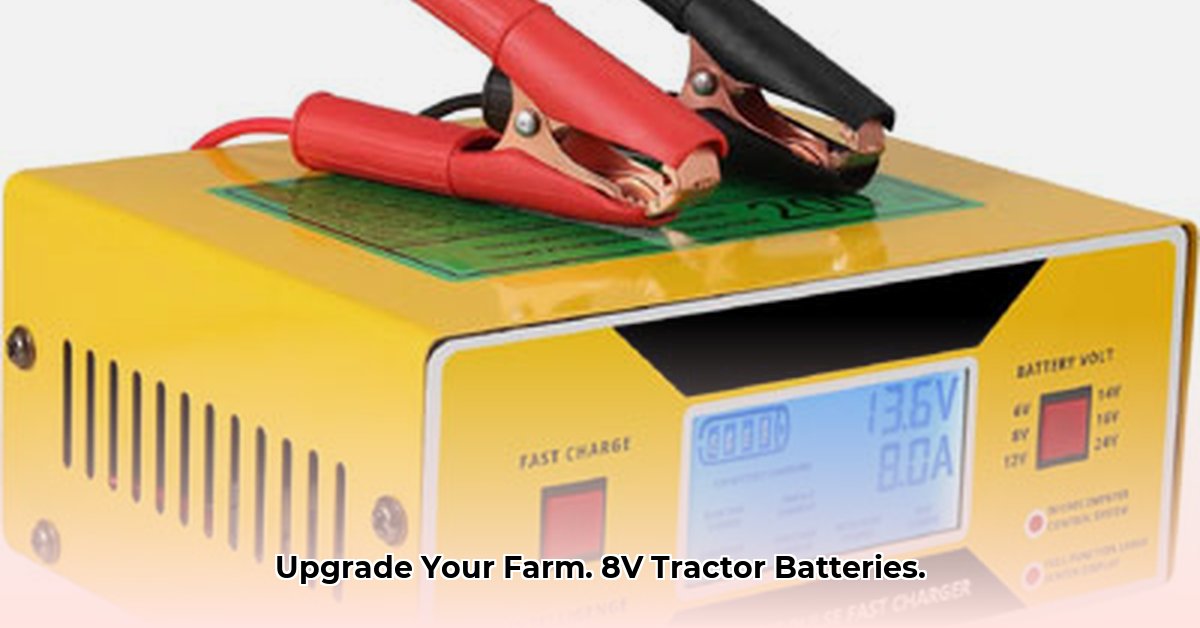
Understanding Your Tractor's Power Needs
Before selecting an 8-volt tractor battery, assess your tractor's power demands. A small, older tractor will have different needs than a large, modern one. Consider the equipment you use (simple tiller vs. complex baler), additional features (power steering, hydraulic implements), and typical operating time between charges. Higher power needs and longer operating times necessitate a battery with higher capacity (measured in Ampere-hours or Ah). Failing to account for these factors can lead to premature battery failure and costly downtime. What are your tractor's specific power requirements? For more information on tractor power, check out this helpful resource on tractor maintenance.
Exploring 8-Volt Battery Options
The primary 8-volt tractor battery types are lead-acid and lithium-ion. Lead-acid batteries are affordable and readily available, but have shorter lifespans and require more maintenance. Lithium-ion batteries offer longer lifespan, lighter weight, and higher efficiency but command a higher initial price. Other technologies are emerging, offering potential future benefits; however, at present, lead-acid and lithium-ion remain the most prevalent choices for agricultural applications. Which battery type aligns best with your budget and long-term goals?
Deciphering Battery Specifications
Several key specifications determine a battery's suitability:
Ampere-hours (Ah): This indicates the battery's power storage capacity. A higher Ah rating means longer operational time before recharging.
Cold Cranking Amps (CCA): This measures the battery's ability to start your tractor in cold weather. Higher CCA is critical in colder climates. Insufficient CCA can lead to failed starts, especially during winter months.
Reserve Capacity (RC): This specifies the time (in minutes) the battery can power essential systems (lights, radio) if the alternator fails. A higher RC provides greater backup power and reduces the risk of being stranded.
Maintaining Your 8-Volt Battery
Proper maintenance significantly extends battery lifespan. Follow these steps:
Clean Terminals Regularly: Corrosion on terminals hinders power flow. Clean them using a wire brush and baking soda solution.
Check Electrolyte Level (Lead-Acid Only): For lead-acid batteries, regularly check the electrolyte level and add distilled water if necessary. Avoid overfilling.
Prevent Deep Discharges: Avoid completely depleting the battery, as this significantly reduces lifespan. Regular charging is key.
Use a Smart Charger: Investing in a smart charger with desulfation capabilities helps revitalize the battery.
Proper Storage: For extended storage periods, fully charge the battery and disconnect it to prevent self-discharge.
Safety Precautions for 8-Volt Batteries
Prioritize safety:
Wear Safety Glasses: Always protect your eyes from potential acid splashes.
Ensure Ventilation: Lead-acid batteries release flammable hydrogen gas; work in a well-ventilated area.
Avoid Short Circuits: Never short-circuit battery terminals to prevent sparks, fire, and injury.
Responsible Disposal: Dispose of spent batteries according to local regulations.
Cost Considerations: Total Cost of Ownership (TCO)
While lithium-ion batteries have higher initial costs, their longer lifespans and reduced maintenance can result in significant long-term savings. Calculate the TCO, including initial purchase, potential replacements, and disposal fees, to determine the most economical option for your farm. Dr. Emily Carter, Professor of Chemical and Biomolecular Engineering at Princeton University, emphasizes the importance of considering the full life-cycle cost when making battery choices: "The initial investment is only part of the equation. Maintenance, replacement costs, and environmental impact should all be considered in the long-term assessment."
8 Volt Tractor Battery Comparison Table
| Feature | Lead-Acid | Lithium-Ion |
|---|---|---|
| Initial Cost | Lower | Higher |
| Lifespan | Shorter | Significantly Longer |
| Maintenance | Higher | Lower |
| Weight | Heavier | Lighter |
| Environmental Impact | Higher (lead content) | Lower (more environmentally friendly materials) |
Choosing the Right 8V Battery: A Step-by-Step Guide
Assess Power Needs: Determine your tractor's power consumption based on its size, age, and the equipment it operates.
Select Battery Type: Choose between lead-acid (affordable, shorter lifespan) or lithium-ion (more expensive, longer lifespan). Consider your budget and maintenance preferences.
Check Specifications: Evaluate Ah, CCA, and RC ratings to ensure the chosen battery meets your tractor's requirements.
Implement Maintenance Practices: Follow the recommended maintenance schedule to maximize battery lifespan and performance.
Prioritize Safety: Adhere to safety guidelines when handling and disposing of batteries.
Calculate TCO: Compare the total cost of ownership of different battery options to make an informed decision.
By carefully considering these factors and following the steps outlined in this guide, you can select the optimal 8-volt battery for your agricultural operations, improving efficiency and minimizing downtime. Remember, consulting your tractor's manual for specific recommendations is crucial.